Samsung Gear S3 frontier smartwatch review
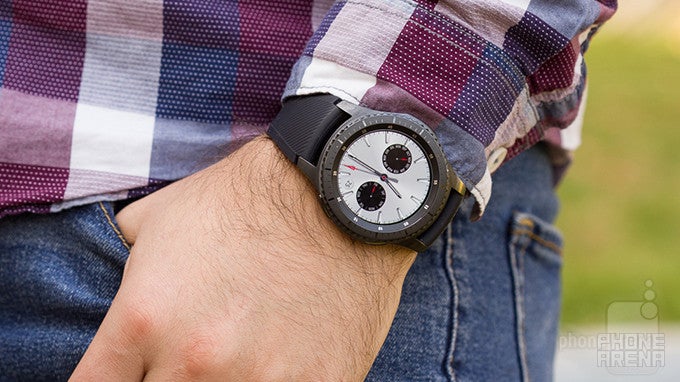
Update: You can now read our Galaxy Watch review!
Introduction
I have a confession to make – I don't like watches. I don't like how they get bumped against doors and get caught in my clothes, I don't like how they remind me of school, where I had to instantly get from one class to another, I don't like the idea that they're intended to serve as a fashion accessory (not unlike a peacock's plumage), and I particularly don't like that they can't do much beyond telling the time – something that my phone does perfectly.
But when I reviewed the Samsung Gear S2 smartwatch last year, I actually enjoyed it. The wearable looked good and felt okay on my wrist, but above all, it could do much more than to tell me that I was late for my weekly editorial meeting. That's why I'm now excited to test the Samsung Gear S3 frontier, which comes with a bigger battery, a built-in speaker, and a dedicated GPS for improved location tracking. Let's find out if it is worth the $350 asking price.
In the box:
- Samsung Gear S3 frontier smartwatch
- Magnetic wireless charging cradle
- Wired charger (connects to the cradle via microUSB)
- Regular and small-sized rubber wrist band
- Quick Start Guide
Design
The Gear S3 frontier is a smartwatch made for adventurers – thick, solid, tough. The rotating bezel is as reliable as before.
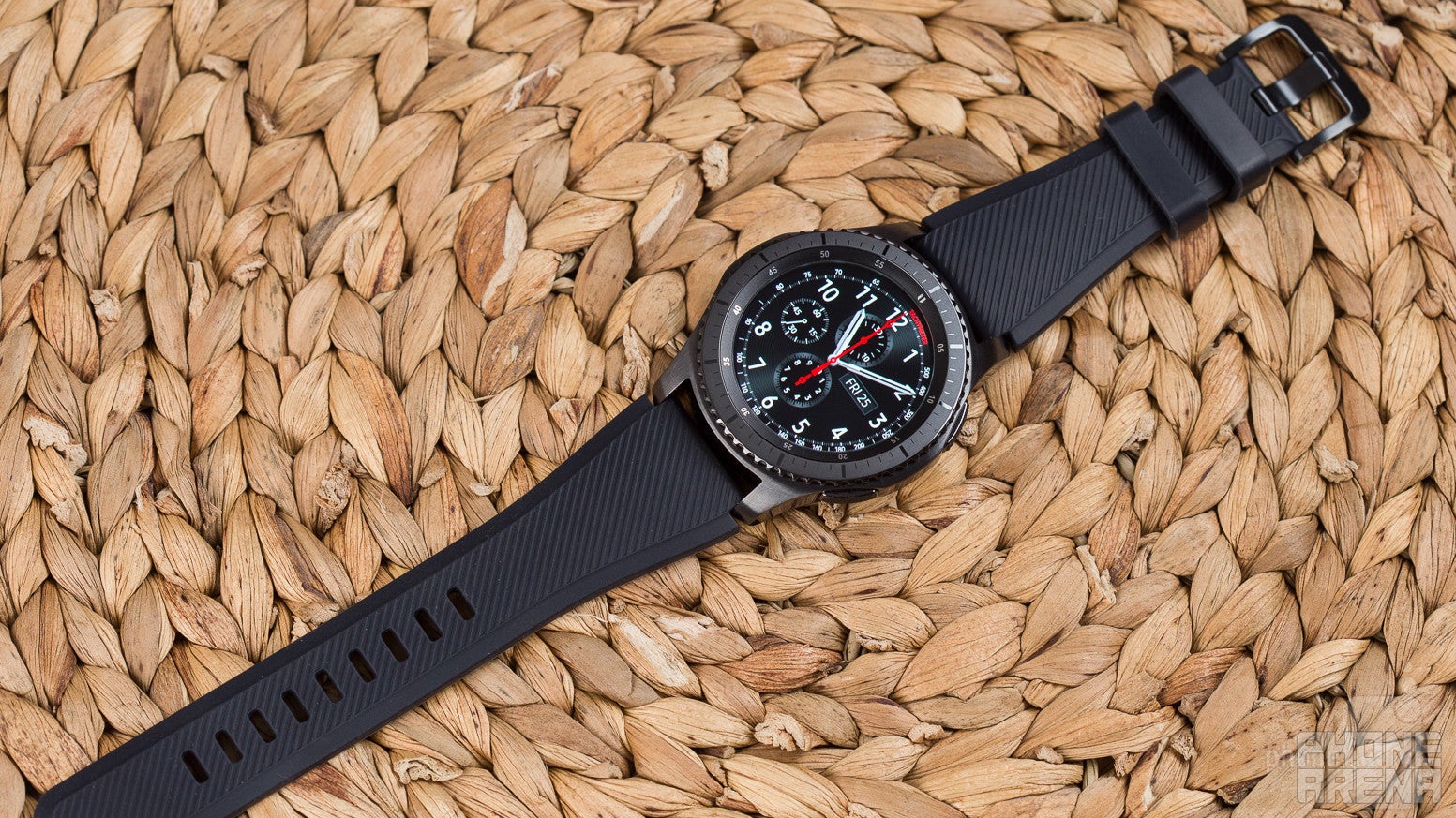
This is no kids’ watch, that’s for sure. It doesn't look great on a lady's hand either, unlike the Samsung Gear S2 from last year. Made of stainless steel, the Samsung Gear S3 frontier is big and solid, with a manly look, and is noticeably on the heavy side. It wraps around the wrist with a thick rubbery band providing a tight, secure grip, further strengthened by a metal clasp. So if I were planning on spending a weekend in Bear Grylls’s company, this would be an ideal smartwatch to wear.
The rugged look and feel of the Gear S3 frontier come as no surprise. Samsung is advertising its smartwatch as IP68-certified and compliant with MIL-STD-810G standards for durability. Or in plain words, the wearable is resistant to water and dust ingress, as well as to unexpected falls and extreme temperatures. Keep in mind that the watch is not suitable for use while swimming, but giving it a quick rinse under the tap after an exercise will do no harm. Meanwhile, the raised bezel surrounding the screen protects its scratch-resistant surface against physical damage.
About the bands the Gear S3 frontier comes bundled with, it is made of what Samsung calls “active silicon”. The material is grippy, meaning that it holds on tightly to the wearer’s wrist. I wouldn’t call this the most comfortable or most beautiful band I’ve ever tried, but I grew used to it over time. Besides, given the fact that the smartwatch is meant to appeal to active, sporty people, I’d give its stock band a pass.
I should point out that wearable is compatible with standard, 22-mm wristbands, so if you’re not happy with the stock band, you’re free to exchange it with one of your own. A leather band, for instance, would be a lot more suitable to wear to a fancy dinner, and Samsung has offerings priced at $30 apiece.
On the right side of the Gear S3 frontier are positioned its Back and Home buttons. Both are readily accessible and easy to feel without looking. But to navigate your way through the user interface, you’ll be mostly using the rotating bezel. This is a design approach I really liked when testing the Gear S2 last year, and I’m happy to see that it is as reliable as it was back then. Each twist results in a satisfying, tactile click, and the ridges on the bezel’s outer rim make it easier to feel. My only complaint is that I had the bezel rotate by accident a couple of times, when it got caught in my running jacket’s sleeve during an exercise.
Display
Bright and crisp, the screen on the Gear S3 frontier is a pleasure to look at.
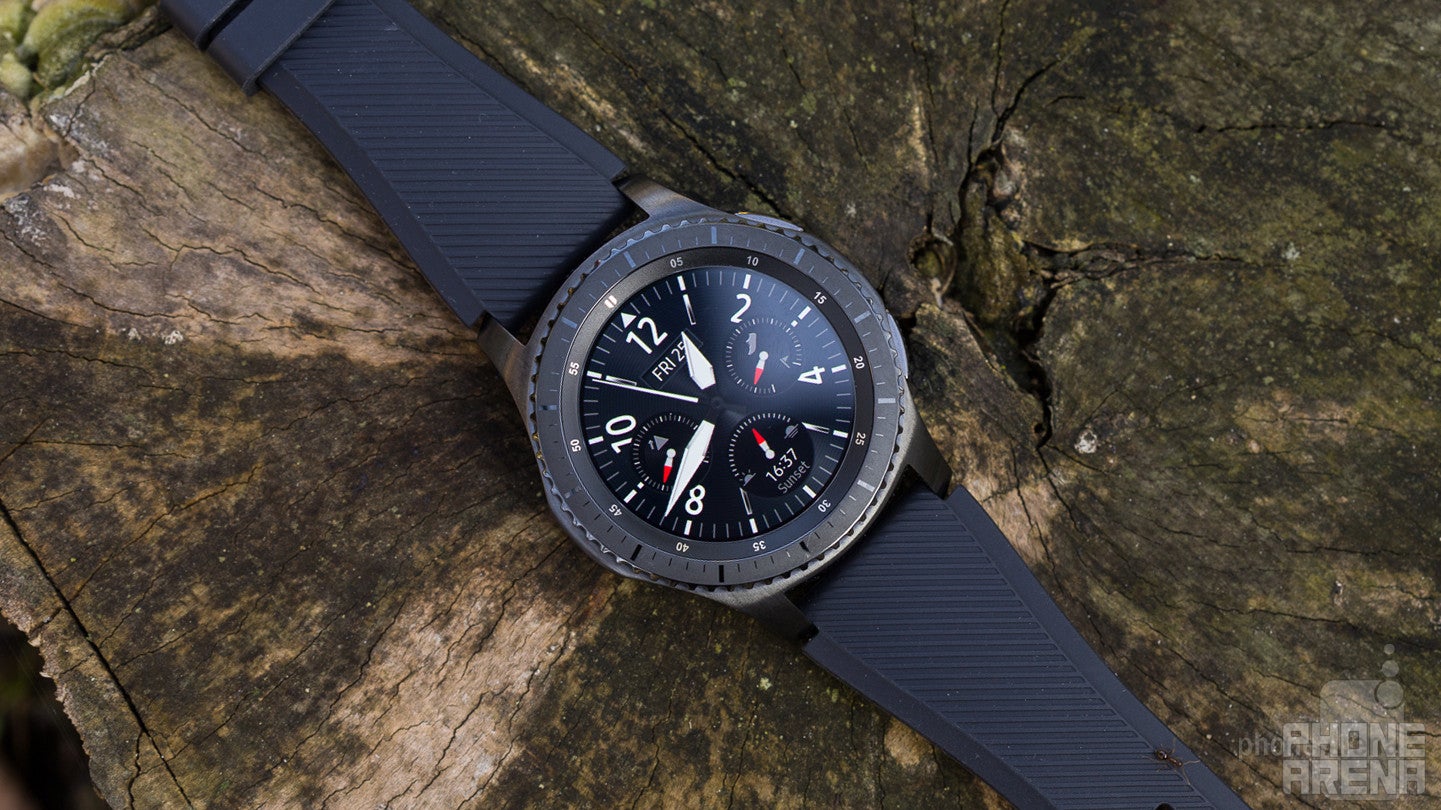
A round smartwatch is a classy smartwatch, and the Gear S3 frontier falls into that category. On its front we have a 1.3-inch circular Super AMOLED display, protected by the scratch-resistant Gorilla Glass SR+, which is designed specifically for wearables.
To sum it all up, the screen is a pleasure to look at. That’s not only due to its high resolution – 360x360 pixels for 278ppi. It is also because it displays graphics in high contrast. Notifications, for example, are nice, sharp, and clearly legible, as text is shown with white letters against a black background. Colors are bright and vivid, making watchfaces, apps, and widgets look their best. And no less importantly, I’ve never experienced issues with outdoor visibility.
One thing I should mention is that the Gear S3 frontier has the option to leave the display always on. When not in use, the screen dims down after a timeout period configurable between 15 seconds to 5 minutes. This does have a serious impact on battery life, but it makes the watch feel more like a watch. If you choose to disable the option, the screen will turn on automatically when you lift your hand or turn your wrist – gestures that work pretty well, in my experience.
As far as sensitivity goes, the Gear S3 frontier performs better than I expected. Moisture can easily make a touchscreen unusable, but the sweat accumulated after a 1-hour workout wasn’t enough to cause any troubles. Still, keep in mind that the touchscreen will start acting up if it gets too wet.
Interface and user experience
The Gear S3 frontier is fast and intuitive to use, but limited app availability is still holding Tizen back.
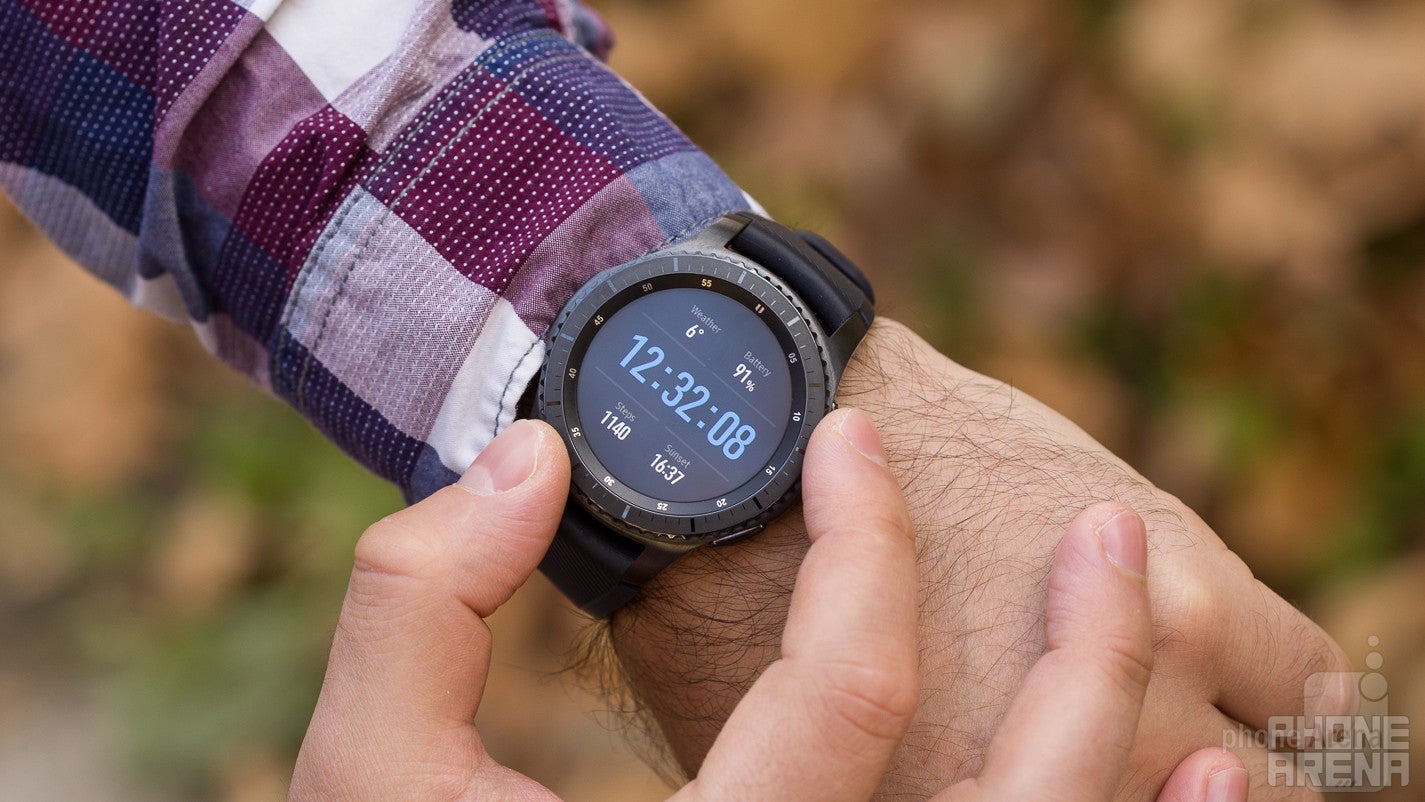
Having total control over both hardware and software has allowed Samsung to create a smartwatch that’s intuitive and easy to use. The Gear S3 frontier runs Samsung’s Tizen operating system, which is designed to look great on the circular touchscreen and to work in unison with the rotating bezel. At the same time, the Samsung-made Exynos chip inside the device is powerful enough to ensure the excellent responsiveness of the interface. It can even run some simple games, even though playing on a tiny touchscreen is anything but comfortable.
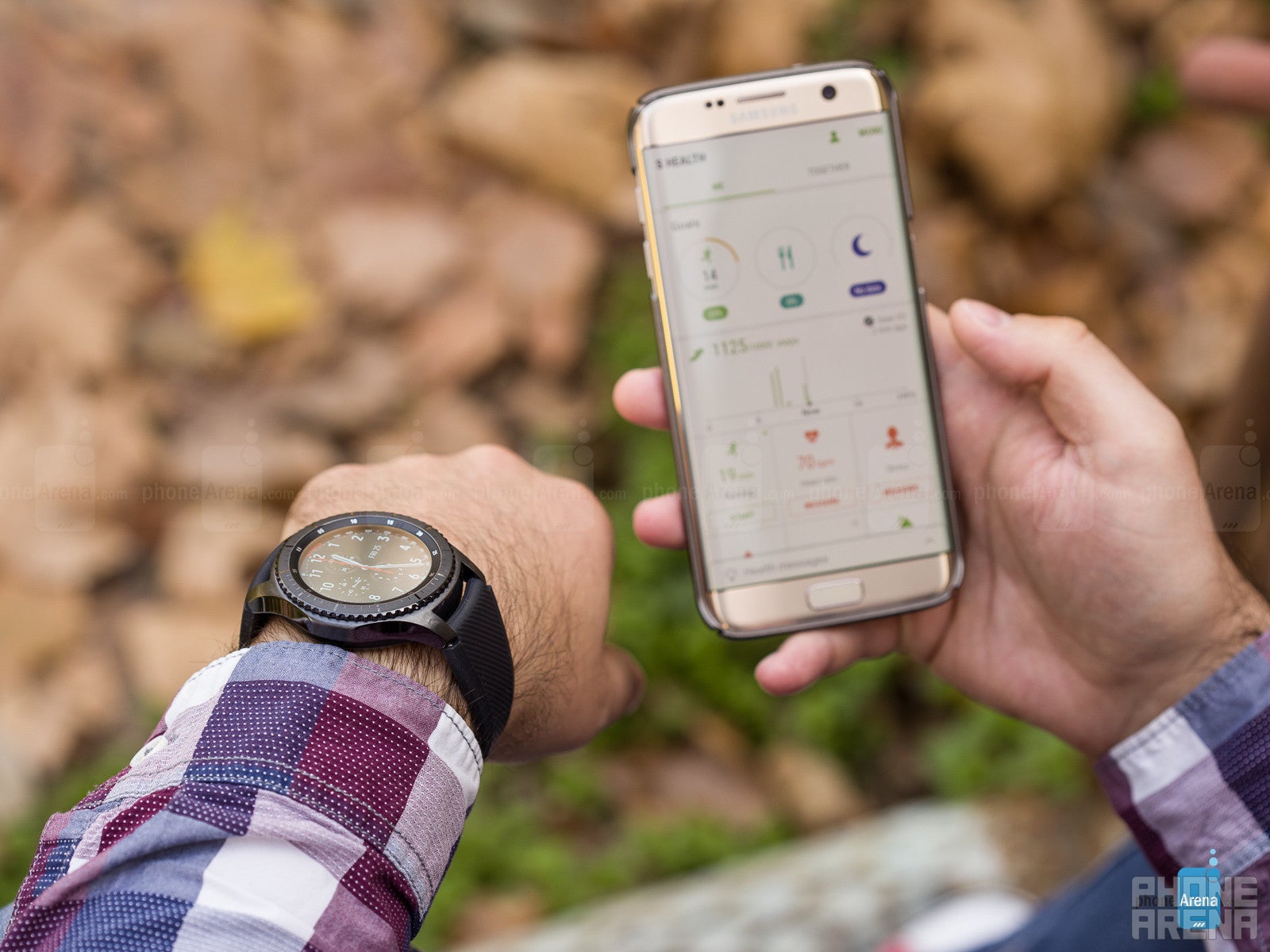
All in all, using the Gear S3 frontier as a smartwatch is pretty fun. In fact, the experience is nearly identical to using last year’s Gear S2. The first time I turned the device on, I was given a quick tutorial explaining the interface and its specifics. I had no troubles customizing the layout of my widgets and selecting the watchface I liked best. Notifications arrive almost instantly, and I can quickly reply to instant messages with a few flicks of the bezel or by speaking out my response. Alternatively, I can type it in using an on-screen keyboard or the option to draw letters one by one. Sure, text input on a screen this small is uncomfortable, but that’s better than not having the option at all.
But the Gear S3 frontier is not without its flaws. One of them is that the selection of apps still feels very limited. I was disappointed to find out that a Spotify app still isn’t available, even though it is clearly advertised on the Gear S3 web page. Samsung confirmed to me that the app was coming soon. Other popular apps, such as Yelp and iHeart Radio, are only available in a small number of countries. Yet I did find a few apps that had potential. HERE Navigator is a GPS navigation software that actually works, and Glympse is an app that lets me quickly share my location with others. I also had to download the Timer and Stopwatch apps. Samsung’s decision to not include these out of the box is odd, to say the least.
As most other smartwatches, the Gear S3 frontier can respond to voice commands – just double press the home button and state your wish. The feature does work, but is not as broad in capabilities as Siri or Google Now. It can do basic things like to call a specific contact, to set an alarm, or to perform a simple online search. However, it can’t handle more complicated queries, such as unit conversions or trivia questions like “How tall is the highest mountain in the world?”.
Activity tracking

A key selling point for the Gear S3 are its fitness tracking capabilities. Equipped with an array of sensors and a GPS, it is supposed to be a powerful tool for activity logging, but is that really the case?
As expected, the Gear S3 frontier handles the basics just right. It can accurately track my steps, the floors I’ve climbed, and it automatically takes occasional heart rate readings throughout the day. It will also give me a nudge every time I sit on my desk for over an hour – annoying, but for my own good. All the data gathered by the timepiece is synced with S Health on my phone, of course, where I’m given an overview of my progress. But to use the more advanced tracking features correctly, I had to go through a few “trial and error” sessions to get the hang of it all. Here follows an example of what I mean.
Although the Gear S3 frontier can detect some basic activities automatically, I prefer to choose the kind of exercise I’ll be doing before I start. This tells the watch to start actively logging my location and pulse to calculate the distance I’ve ran, the calories I’ve burned, the heart rate I’ve maintained, and so on. I played soccer this weekend, and since there was no preset for that, I chose running mode and disabled the auto-pause feature. An hour later, I had supposedly burned only 77 calories and ran only half a mile. A few days earlier, I did some archery practice, which is a much lighter exercise. There was no preset for that either, so I chose “Other Workout”. After 45 minutes of shooting, the Gear S3 frontier estimated that I had burned a whopping 258 calories. These calculations just couldn’t be right.
I’m not trying to present the Gear S3 as a poor fitness tracker, but obviously, it isn’t perfect either. The thing is that the wearable is only accurate and reliable in environments with less variables, such as when using the stepper in the gym or when running in the park. But I see no excuse for it being unable to properly track my activity during a sports game, especially when it is the most popular sport in the world.
UPDATE: Apparently, I've been using the Gear S3 frontier incorrectly. After reaching out to Samsung, I was told that the Running mode was made specifically for running, and the smartwatch's auto detection abilities should be relied on during activities like soccer, table tennis, badminton. I tested the S3 frontier a few more times, and indeed, it automatically started tracking my activity during my soccer practices. The estimate for calories burned was much more realistic this time around. But my exercise was logged as "Other Workout", and the downside of that is that my pulse or distance traveled aren't recorded. Oddly, the S Health app on my smartphone has "Soccer" listed as an exercise type, but the Gear S3 doesn't.
Connectivity
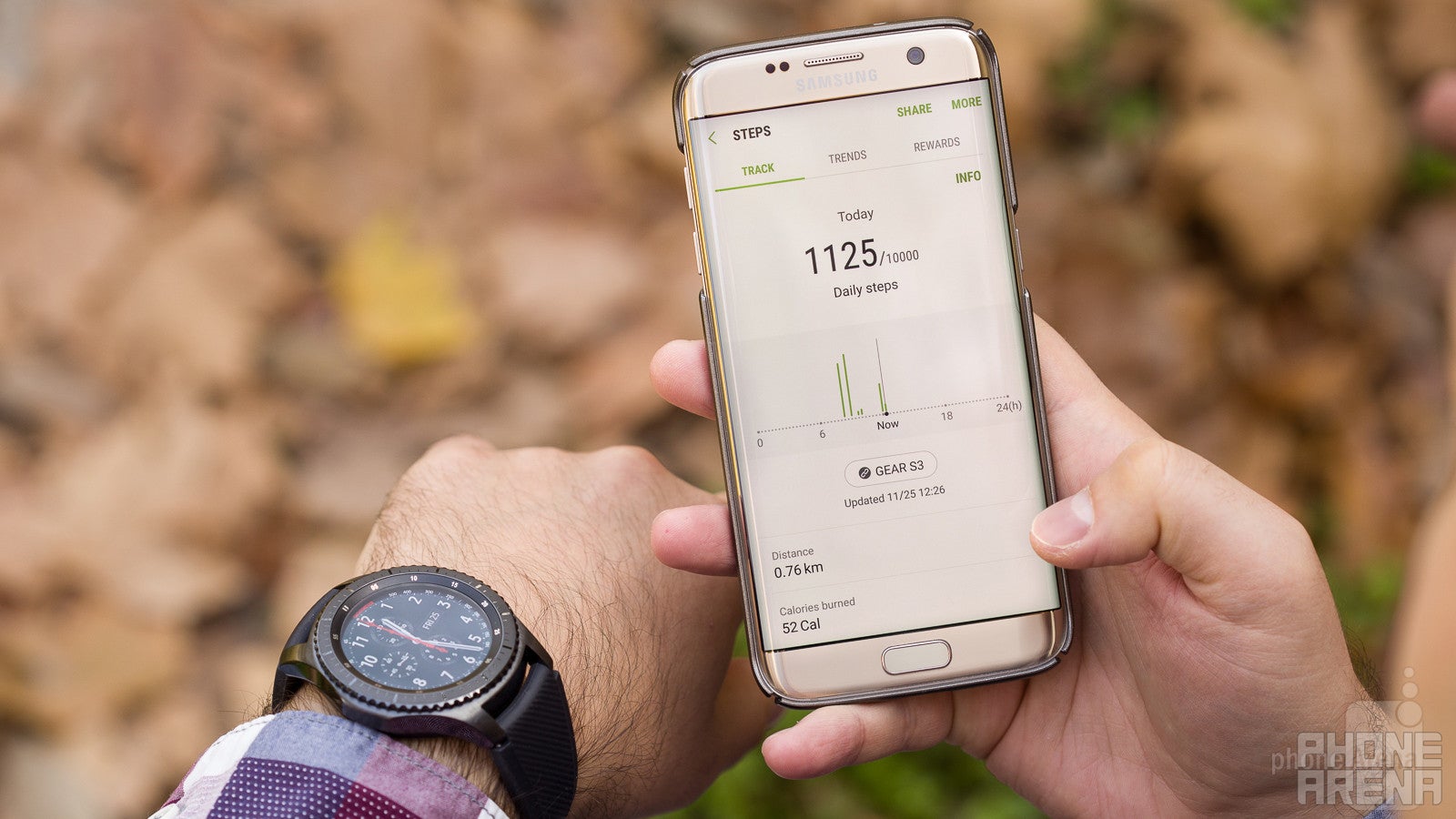
The Samsung Gear S3 frontier that I’m reviewing connects to a smartphone over Bluetooth and maintains the connection at a distance of up to 30 feet, as long as there’s nothing in the way – a typical distance for the wireless standard. Wi-Fi connectivity is also available, in case the Bluetooth connection drops. Passwords stored on your phone are synced with the wearable, meaning that it will automatically connect to every Wi-Fi network your phone has access to. Neat!
Having Wi-Fi connectivity allows the Gear S3 frontier to work independently – at the cost of increased battery consumption. The watch will keep on delivering notifications that you receive on your phone. You’ll be also able to stream music, to respond to incoming emails and instant messages, and to exchange regular texts. However, I couldn’t get phone calls to route over Wi-Fi, even though there should be a way of doing that, according to Samsung’s web page. After reaching out to Samsung, it was clarified to me that the feature may not work with certain carriers.
Speaking of phone calls, you can make them straight from your Gear S3 frontier, as long as you have the LTE version of the device. Needless to say, that model can also connect to the carrier’s cellular network for anytime, anywhere internet access.
Samsung Pay
Samsung Pay – Samsung's mobile payments platform – can be used straight from the Gear S3 frontier. The wearable supports both the MST and NFC standards, so it can be used to make contactless purchases from your wrist at terminals where swiping or tapping is possible. What's more, you're not required to have the watch paired to a Samsung smartphone in order to use Samsung Pay. Any compatible Android phone will do. Also, you should be able to make payments without your phone nearby, although some limitations will apply in this case. Samsung Pay is currently available in the following markets: USA, Korea, China, Australia, Spain, Singapore, Brazil, and Puerto Rico.
Multimedia and call quality

The speaker is good enough to handle a phone call, however. While you risk looking silly in public while talking over your watch, you have the option to do so. And phone calls are clear enough on both sides of the line, although I do admit that I had to turn the speaker volume to the maximum in order to hear the other person properly.
Battery life and charging
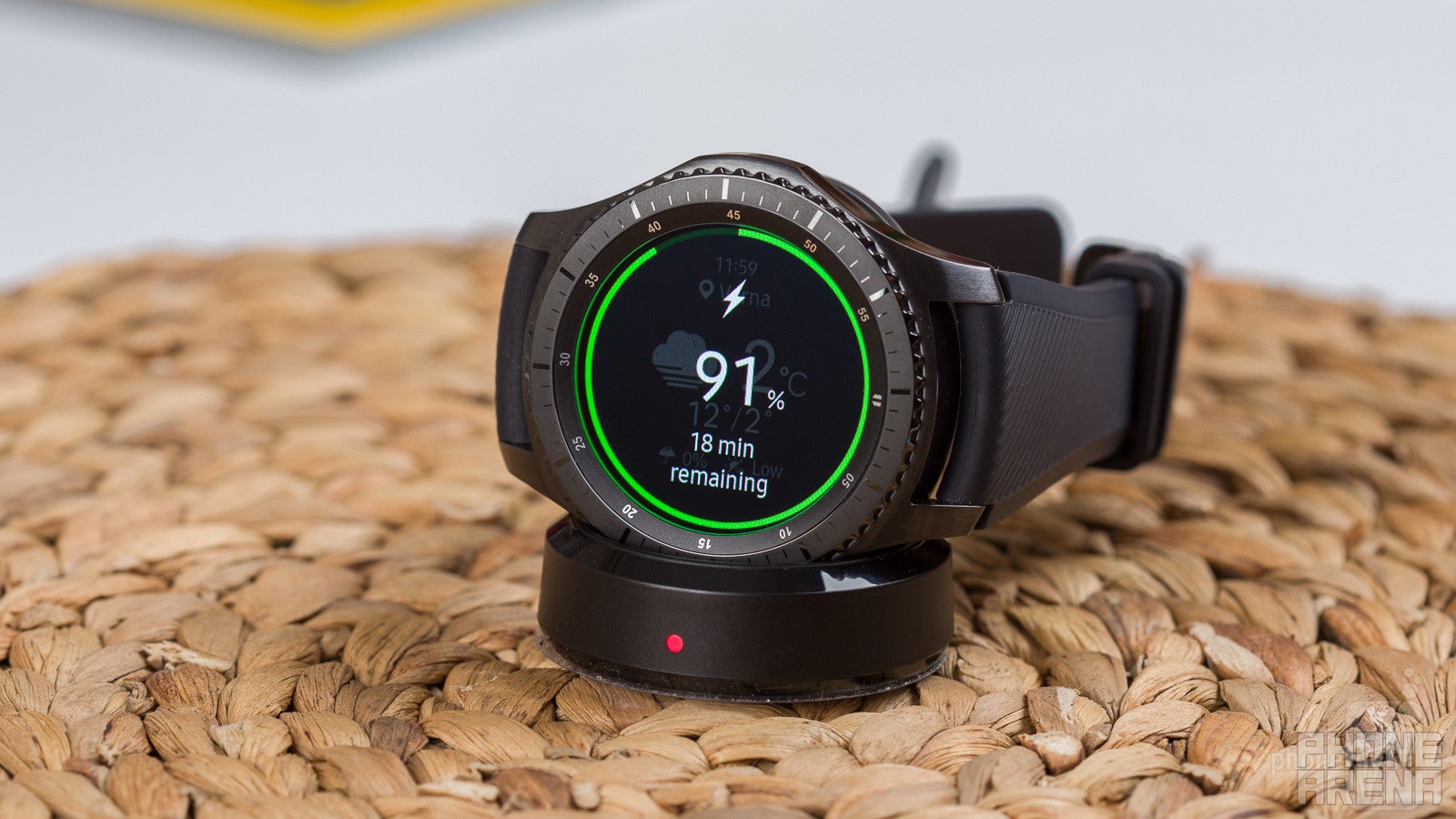
As expected, the Samsung Gear S3 frontier can last several days between charges, mostly thanks to its 380mAh battery. Personally, I was using it with the Always-on Display option enabled and the brightness set to 7/10 – not the most economical configuration possible – yet it easily lasted through two full days of usage.
Of course, your mileage will vary, depending on how you’re using the Gear S3 frontier. I noticed that workout tracking with heart-rate monitoring and GPS enabled consumed about 10 percent of battery life per hour. But when used lightly and with the Always-on Display option disabled, the watch would easily last you even longer than the couple of days I was getting.
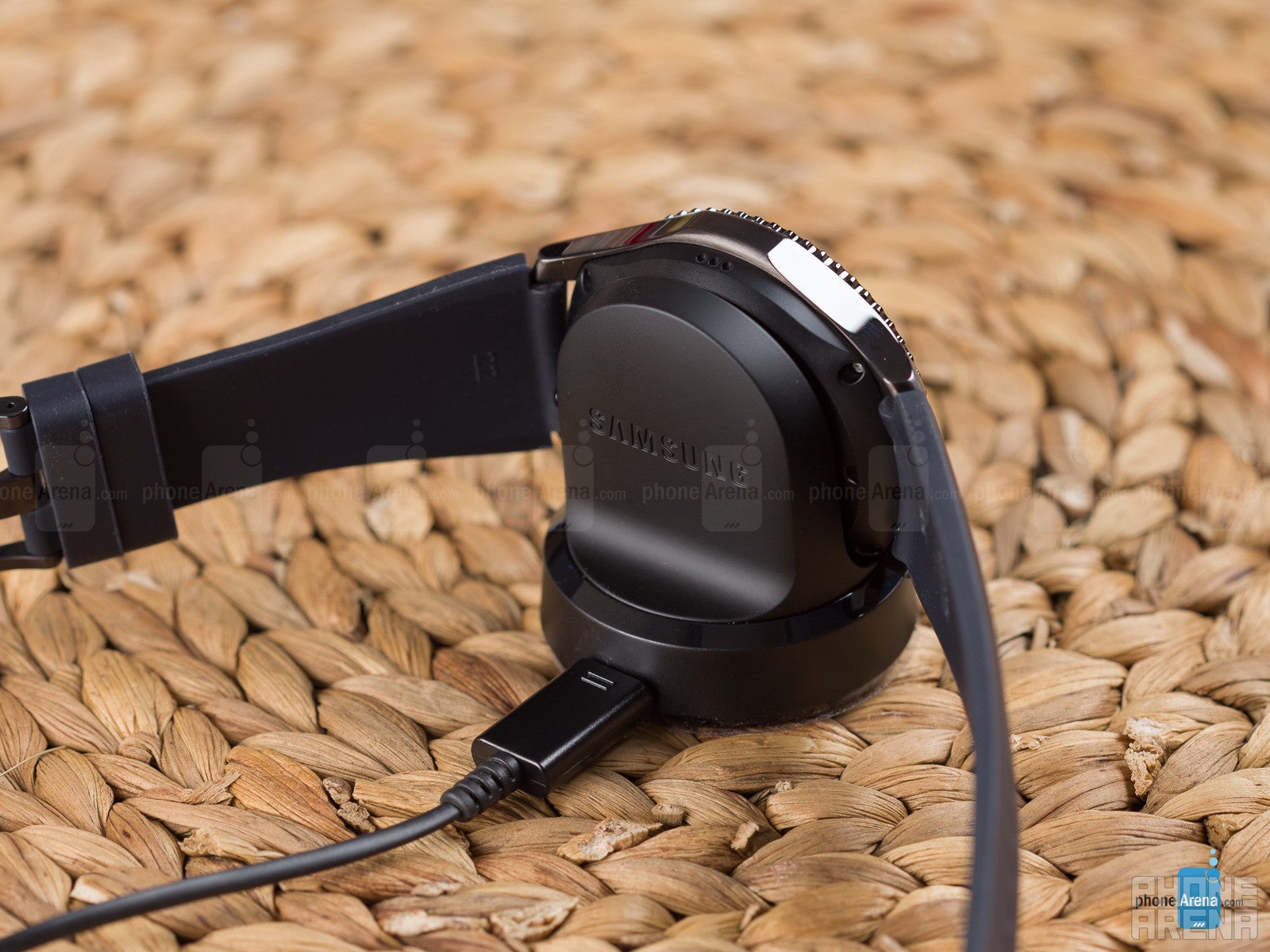
Speaking of charging, the magnetic charging cradle is an elegant complement to the Gear S3 frontier. It uses wireless charging to transmit power to the wearable, and an LED indicates when the charging process has ended. I only wish that the wire connecting the wall charger with the cradle was a bit longer.
Conclusion
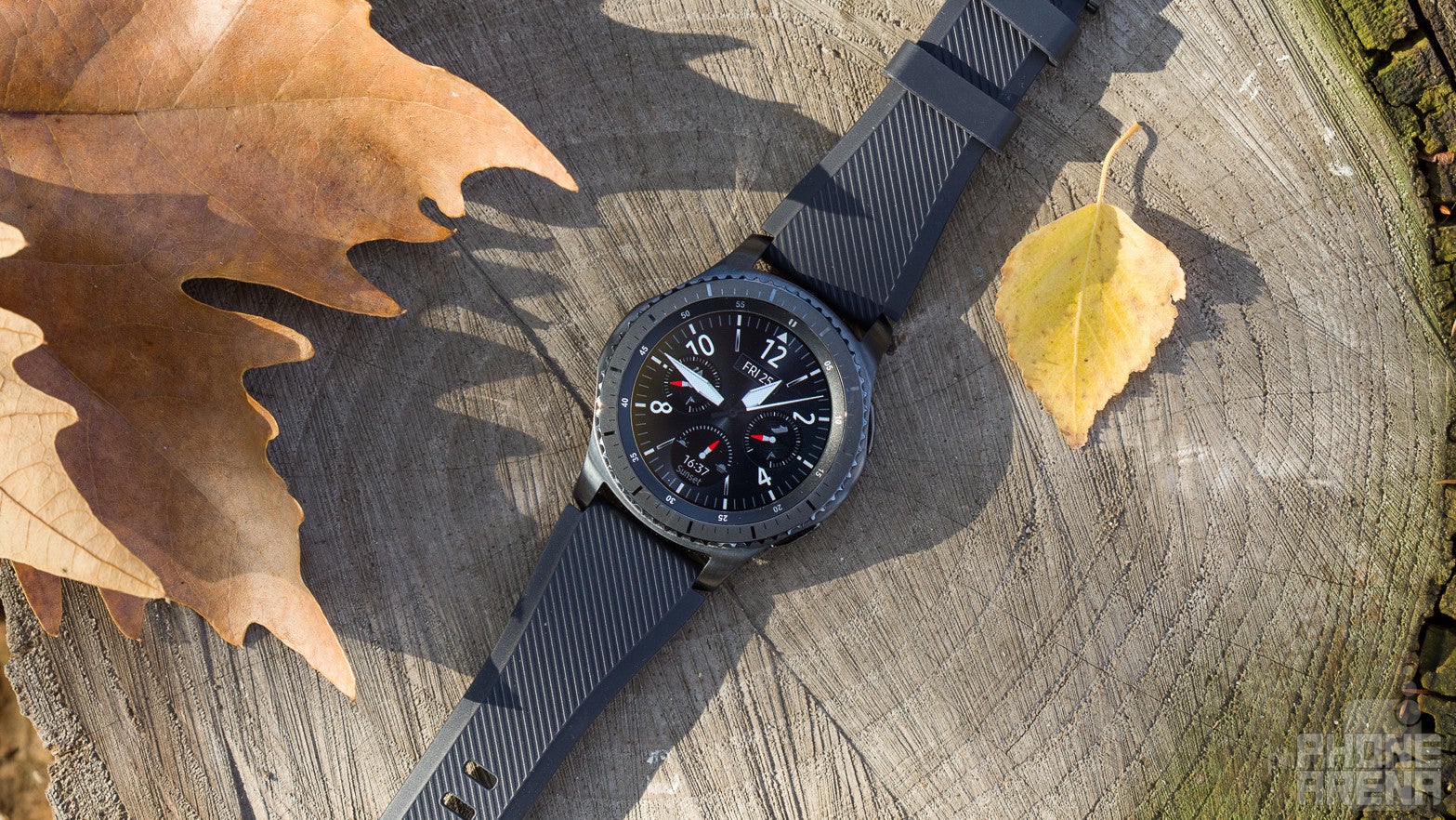
Last year’s Gear S2 was already a great smartwatch. While a little rough around the edges, it set the bar high for what was expected out of a wearable – great performance, ease of use, long battery life, to name a few examples. Because of this, the Gear S3 frontier only feels like a minor upgrade, even though it is still one of the top smartwatches to get this holiday season. And if you’re in the market for a smartwatch, I’d still recommend getting one, although not before pointing out a thing or two.
First of all, I really think the Gear S3 should be improved to be a better activity tracker. There’s no shortage of sensors on it, that’s for sure, but a watch of this class should be able to accurately track a broader range of activities and sports. On the other hand, if you’ll be using yours mostly at the gym or while running in the park, then Samsung’s wearable should suit your needs just fine.
Another drawback of the Gear S3 is that the selection of apps still leaves room for improvement, although I do appreciate seeing a number of familiar names in its catalog: Uber, Yelp, iHeart Radio, HERE Maps, and Nike+, for instance.
That aside, the Gear S3 frontier is a pretty great smartwatch – it is fast, it is durable, it packs a long-lasting battery, and delivers notifications to your wrist with style. As I’m writing these lines, Samsung’s wearable is on sale for $300 at major retailers across the US, which is a more than reasonable price for what you’ll get in exchange.



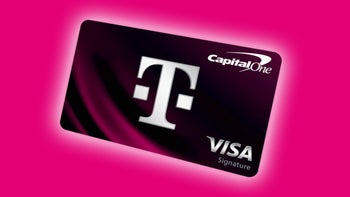




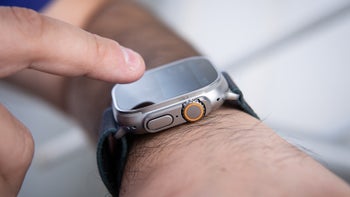
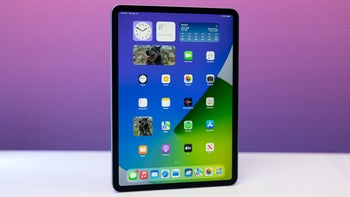



Things that are NOT allowed: